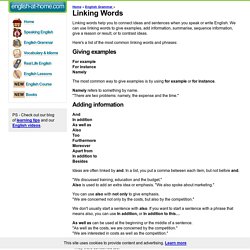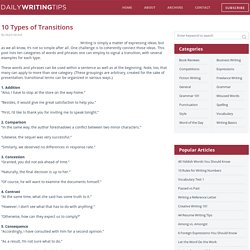

Welcome to English, step 3-4 (Spring 2015) Conjunctions and subjunctions combine clauses.

What is a clause? It´s part of a sentence. There are two types of clauses: 1. Independent clause = huvudsats 2. You can combine: 1. 2. There are very few conjunctions but many subordinate conjunctions. Here is a list with the conjunctions. Here are some subordinate conjunctions. So, what do they mean? TIME: when=när, while = medan, since =sedan, before =innan, after = efter att, until = tills/till (om tid), once = då(at the moment when)
Kärlek, vetenskap, empati och en jäkla fin textbindning - Robin Smith. (Det här inlägget handlar om en skrivövning för engelska på gymnasiet) ”Three passions, simple but overwhelmingly strong, have governed my life:” så inleder Bertrand Russell prologen till sin självbiografi från 1956.

Han fortsätter genom att lista de tre passioner som styrt hans liv: the longing for love, the search for knowledge, and unbearable pity for the suffering of mankind. Det kan låta svulstigt och pretentiöst, men för en man som aldrig vilade länge i en och samma famn, som gjorde sig världskänd som matematiker och filosof, tilldelades Nobelpriset i litteratur och som kämpade mot kärnvapen och för världsfred större delen av sitt liv kan det nog få gå an. ”Mitt namn är Russell, Bertrand Russell” I undervisningen är prologen är ett väldigt fint verktyg för att lära eleverna att strukturera en text och ge dem möjligheten att reflektera över vuxenlivet.
What I Have Lived for With equal passion I have sought knowledge. This has been my life. Hurra! 5 av 5 elever älskar textbindning. Linking words, alphabetical order. Transitions sentences 1 red. Linking words Flashcards. Transitions are Like Road Signs. Transitions by Shmoop. Writing a Good Transition Statement by Shmoop. Coherence without linking words. Writing - Transitions - THEREFORE, THUS, CONSEQUENTLY. Linking words. Home » English Grammar » Linking words help you to connect ideas and sentences when you speak or write English.

We can use linking words to give examples, add information, summarise, sequence information, give a reason or result, or to contrast ideas. Here's a list of the most common linking words and phrases: Giving examples For exampleFor instanceNamely The most common way to give examples is by using for example or for instance. Namely refers to something by name. " Adding information AndIn additionAs well asAlsoTooFurthermoreMoreoverApart fromIn addition toBesides Ideas are often linked by and. "We discussed training, education and the budget.
" You can use also with not only to give emphasis. " We don't usually start a sentence with also. As well as can be used at the beginning or the middle of a sentence. " Too goes either at the end of the sentence, or after the subject and means as well. " Apart from and besides are often used to mean as well as, or in addition to.
" Summarising Sequencing ideas. 10 Types of Transitions. By Mark Nichol Writing is simply a matter of expressing ideas, but as we all know, it’s not so simple after all.

One challenge is to coherently connect those ideas. This post lists ten categories of words and phrases one can employ to signal a transition, with several examples for each type. These words and phrases can be used within a sentence as well as at the beginning. Vocabulary - though, although, even though, despite, in spite of - YouTub. Although, Though, Despite and However - Online Language Quiz. 40 Useful Words and Phrases for Top-Notch Essays. 17.7KGoogle +202 1702 2322 25 August, 2014 The secret to a successful essay doesn’t just lie in the clever things you talk about and the way you structure your points.

To be truly brilliant, an essay needs to utilise the right language. You could make a great point, but if it’s not intelligently articulated, you almost needn’t have bothered. Developing the language skills to build an argument and to write persuasively is crucial if you’re to write outstanding essays every time. General explaining Let’s start by looking at language for general explanations of complex points. 1. Usage: “In order to” can be used to introduce an explanation for the purpose of an argument.
Example: “In order to understand X, we need first to understand Y.” 2. Usage: Use “in other words” when you want to express something in a different way (more simply), to make it easier to understand, or to emphasise or expand on a point. Example: “Frogs are amphibians. 3. Example: “Plants rely on photosynthesis. 4. Structure writing. Structure seasons. Linking words. Linking words and expressions to show contrast.